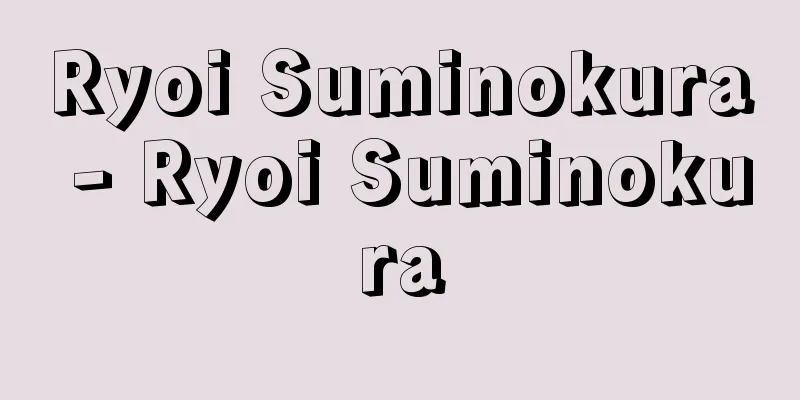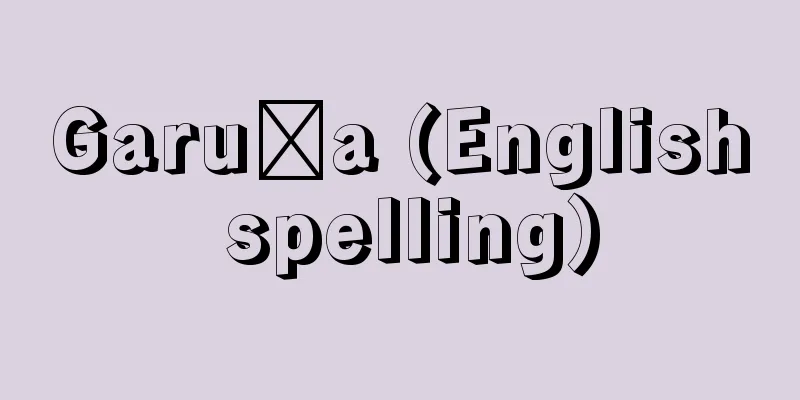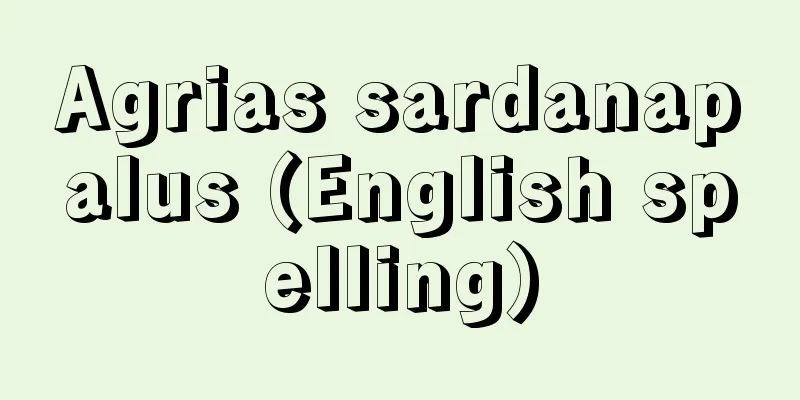Ryoi Suminokura - Ryoi Suminokura

|
Year of death: July 12, 1614 (August 17, 1614) Year of birth: Tenbun 23 (1554) A wealthy merchant in Kyoto in the early modern period, a master of river reclamation civil engineering works, and a red seal ship trader. The eldest son of Yoshida Sokei and the daughter of Nakamura. His real surname was Yoshida, his given name was Yoshichi, and his given name was Mitsuyoshi. His ancestors served the Muromachi Shogunate as physicians. They also ran a financial business as a dokura in Saga, and their shop name was Suminokura. His father Sokei was also famous as a physician, and engaged in the kango trade, purchasing medicines, etc. Ryoi helped with the family business under Toyotomi Hideyoshi's administration, but later he handed the medical duties over to his younger brother Sonosuke, and from around 1600 (Keicho 5), he approached Tokugawa Ieyasu, seeing the times. A bold and free-spirited person, he engaged in red seal ship trade with Annamoku Tokyo (Indochina Peninsula) from around 1600, and with the cooperation of his eldest son Yoichi (Soan) and others, he carried out trade almost every year, and was also a representative envoy of Japan. On the way back in the same year, he was involved in a shipwreck at sea, which claimed many lives, after which he handed over trade to Yoichi. Ryoi inherited his father's scientific talents, was knowledgeable in mathematics and geography, and had advanced skills in civil engineering. In the same year, upon seeing the effort required to transport rice, lumber, and other goods from Tanba to Kyoto by horse and man, he thought of digging a canal on the Oi River and freeing up the flow of goods by using Takase boats for river transport. With permission from the shogunate, he personally led the excavation work, completing it in the following years and obtaining a patent for the collection of river navigation fees and warehouse fees, which became income for Suminokura. Next, in the same year, the shogunate ordered Ryoi to irrigate the Fuji River, which was completed the following year. In the same year, he was ordered to irrigate the Tenryu River, but this was a difficult task and he was unsuccessful. In the same year, he planned a canal extending from Nijo in Kyoto to Fushimi, and overcame difficult conditions at his own expense to complete the excavation of the Takase River to connect it to the Yodo River, transporting timber, food, firewood, charcoal and other goods to the city of Kyoto. The shogunate collected tolls on the Takase River, which became revenue for the shogunate and Suminokura, and for generations Suminokura controlled river traffic on the Yodo River and the Takase River. He died of illness shortly after the Takase River was completed. He is buried at Saga Nison-in Temple. <References> "Suminokura Documents" (included in Volume 14 of Dai Nihon Shiryo, 12 volumes), "Suminokura Documents" (owned by Suminokura Goro, Kyoto), "Suminokura Documents" (owned by Takanawa Museum of Art), Hayashiya Tatsusaburo, "Suminokura Ryoi and His Son," Nakata Yasunao, "Suminokura Ryoi, a Great Businessman in the Early Modern Period" (Kin'yū Journal, August 1974 issue) (Yasunao Nakata) Source: Asahi Japanese Historical Biography: Asahi Shimbun Publications Inc. About Asahi Japanese Historical Biography |
|
没年:慶長19.7.12(1614.8.17) 生年:天文23(1554) 近世初頭の京都の豪商,河川開墾土木工事の大家,朱印船貿易家。吉田宗桂と中村氏の娘の長男。本姓吉田,名を与七,諱は光好。先祖は室町幕府に医者として仕えた。また嵯峨の土倉として金融業を営み,屋号を角倉と称した。父宗桂も医者として名高く,勘合貿易に従事し,薬種類の購入など行った。了以は豊臣秀吉政権下では家業に協力していたが,のち医者は次弟の宗恂にやらせ,慶長5(1600)年ごろより時代をみて徳川家康に近づいた。豪放闊達な人物で,同8年ごろより安南国東京(インドシナ半島)との朱印船貿易に従事し,長男与一(素庵)らの協力を得て毎年のように実施し,日本を代表する使節でもあった。同14年の帰途海難にあい,犠牲者を出してから,貿易は与一に譲っている。 了以は父の科学者的素質を受け,数学や地理に明るく,土木工事の技術に進んだ力量を持っていた。同9年丹波から京都に米穀や材木などを人馬で運送している労力をみて,大堰川の開疏を行い,高瀬船による河川交通によって,物資の流通を自由にすることを考え,幕府の許可を得て同10年,同11年に開削工事を自ら陣頭に立って完遂し,その河川運航料や倉庫料の徴収が特許され,これが角倉の収入となった。次いで幕府は同11年了以に富士川の疏通を命じ,翌年工事が達成された。同12年天竜川の開疏を命じられているが,これは難工事で成功していない。同16年,京都二条から伏見に至る運河を計画,淀川に接続させる高瀬川の開鑿を,自費で困難な条件を克服して完成し,京都の町に木材,食糧,薪炭などの物資が運送された。幕府は高瀬川の通航料を徴収し,幕府と角倉の収益とし,角倉は代々淀川の河川交通や高瀬川を支配した。高瀬川の完成直後に病没。墓地は嵯峨二尊院。<参考文献>「角倉文書」(『大日本史料』12編14所収),「角倉文書」(京都角倉吾郎氏蔵),「角倉文書」(高輪美術館蔵),林屋辰三郎『角倉了以とその子』,中田易直「近世初頭の大事業家角倉了以」(『金融ジャーナル』1974年8月号) (中田易直) 出典 朝日日本歴史人物事典:(株)朝日新聞出版朝日日本歴史人物事典について 情報 |
Recommend
Nonbelligerency
A state of affairs between a third country that do...
Mount Shirane
A stratovolcano on the border between Gunma and Na...
CNEXO
...Particularly noteworthy areas include the many...
Theodahad
?‐536 King of the Ostrogoths. Reigned 534-536. Nep...
Baleen - Baleen
…They also use the bioluminescence of lanternfish...
Kyomai - Kyoto dance
A type of Kamigatamai (Kamigata Dance) , a Japanes...
Autogiro (English spelling)
A type of rotorcraft that generates lift using rot...
Kirishitan Mono (Christian Stories) - Christian Stories
A general term for plays that have Christianity as...
Citellus beecheyi (English spelling) Citellusbeecheyi
…[Yoshiharu Imaizumi]. … *Some of the terminology...
Bellingshausen
His Russian name was Faddei Bellinsgauzen. He was ...
Carnauba palm - Carnauba palm
...The sago palm (illustration) is famous for its...
Pochteca (English spelling)
A group of privileged long-distance traders who em...
Pentheus
...He was persecuted by Lycurgus, king of the Edo...
Utagawa Kunisada - Utagawa Kunisada
An ukiyo-e artist from the late Edo period. A pup...
Phocomelia - Seal syndrome
A deformity in which the long bones of the limbs a...









